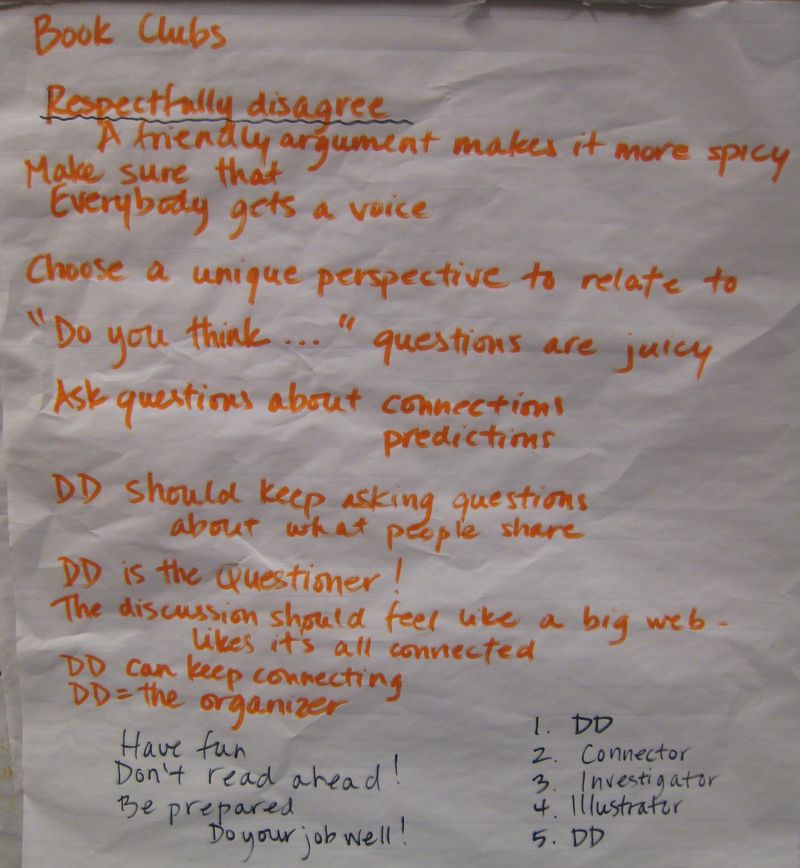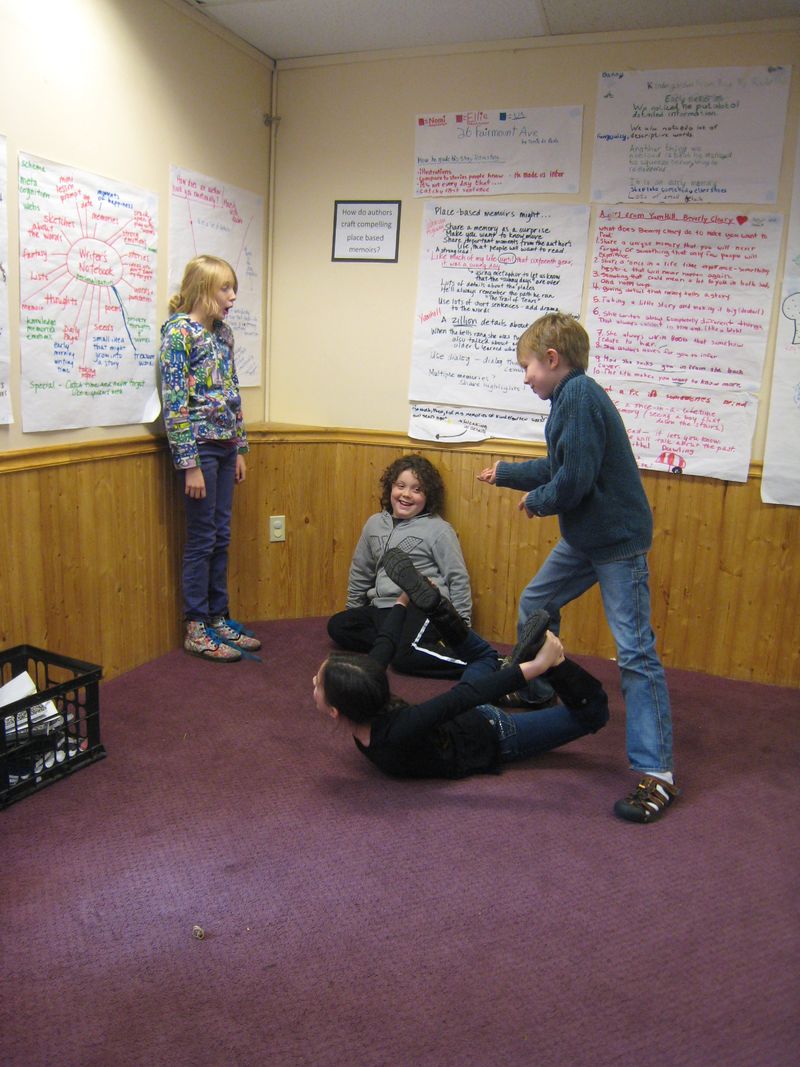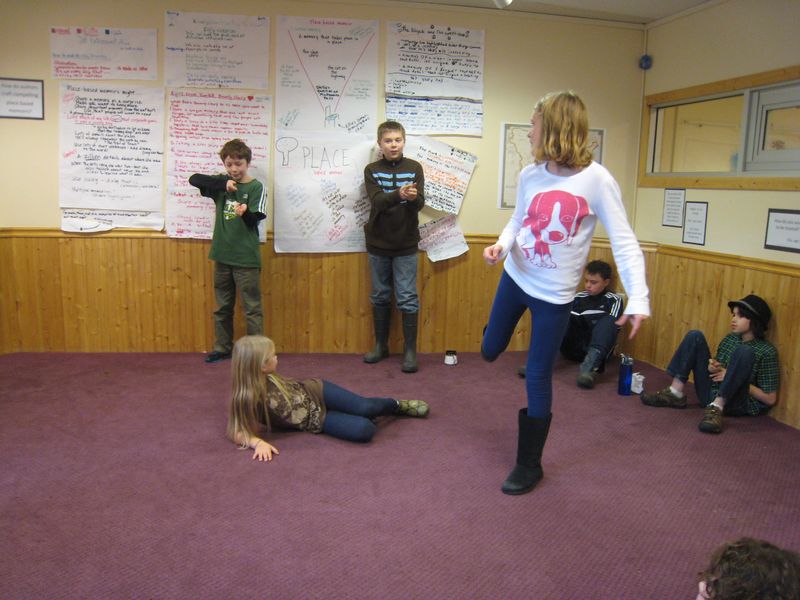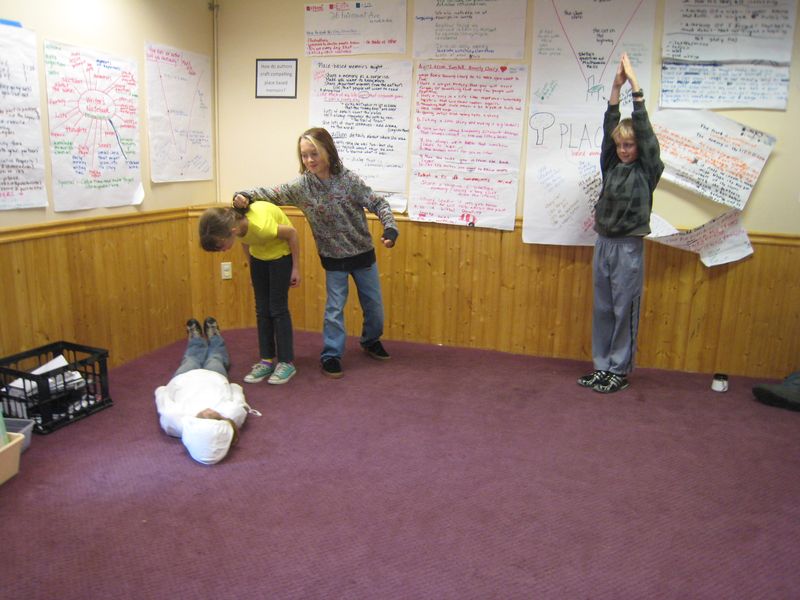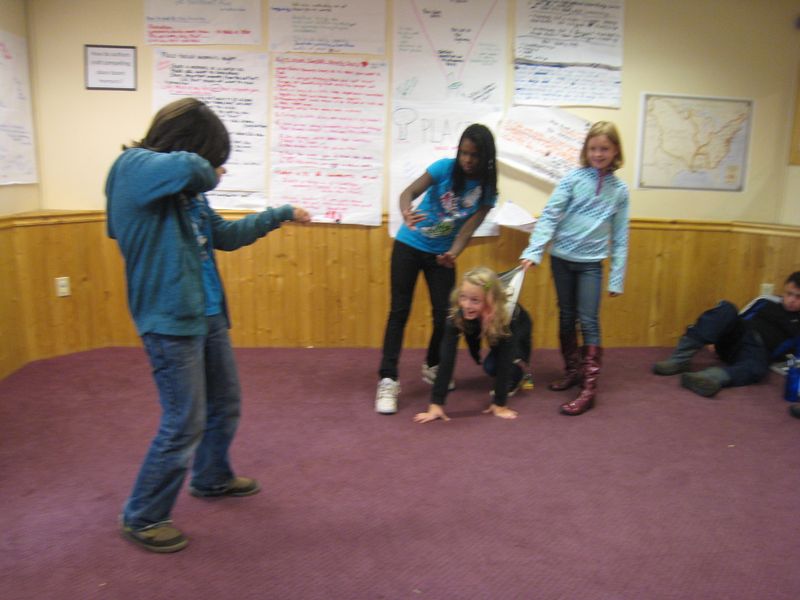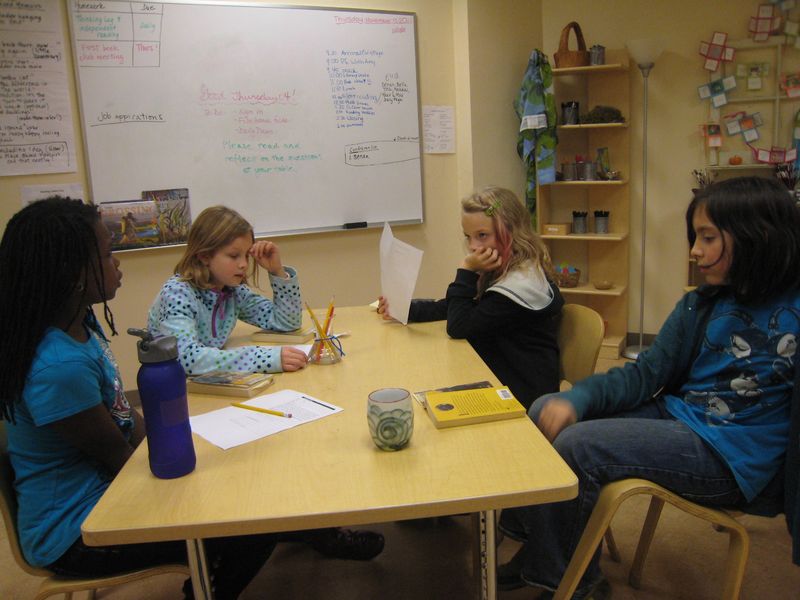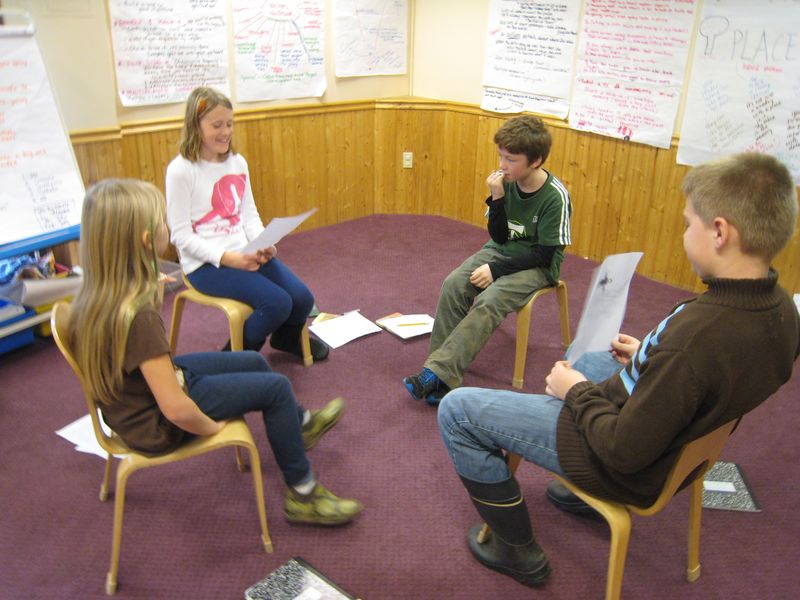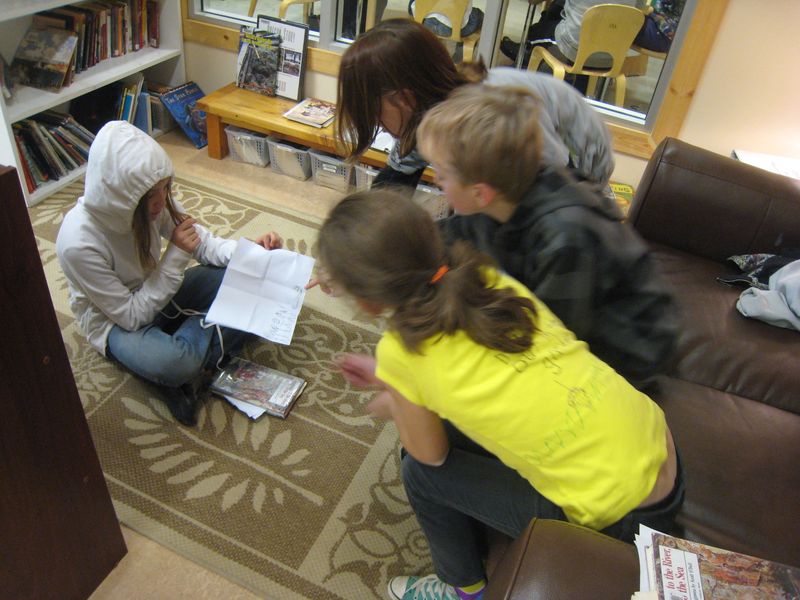Literature Circles kicked off in Opal 4!
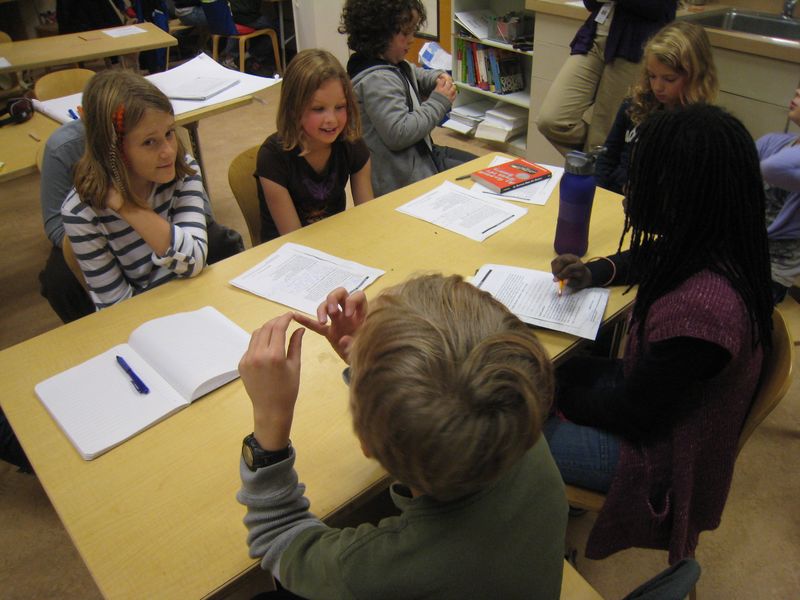
Opal 4 students met in their new book clubs on Tuesday, November 15. They sat expectantly, eager to get their own copy of the Lewis and Clark historical fiction text they will be reading in their book club (officially known as literature circles in teacher-speak.)
Literatures Circles are a structure we use in the upper grades at Opal School.
A literature circle is a students' equivalent of an adult book club, but with greater structure, expectation and rigor. The aim is to encourage thoughtful discussion and a love of reading in young people. The true intent of literature circles is "to allow students to practice and develop the skills and strategies of good readers" (DaLie, 2001). (http://en.wikipedia.org/wiki/Literature_circle)
Literature Circles are small groups of students. Each student reads the same book, in manageable chunks, and meets to discuss what they have read. The students run their own discussion through the roles or “jobs” they take on each time they meet. Over the last couple of weeks we have been practicing the book club jobs and experimenting with how they contribute to and support book club discussions.
On Monday we discussed the role of the Discussion Director.
Shannon (Teacher): What is the role of the Discussion Director?
MM: To keep the conversation going.
RC: The Discussion Director keeps the group on topic.
AW: Like studio talk.
RC: Not like studio talk. Sometimes discussions and connections can go off topic, you just have to make sure that they come back.
KB: Well, if they start talking about Halloween candy, that’s off topic. You can ask the group to think about a part of the book. Do you think that was a truth or a lie?
Teacher: What other kinds of questions would the Discussion Director ask?
RC: How did you feel when such and such happened?
Teacher: Open ended questions where everyone can share their opinion and have their own idea?
MM: Yes, like, “Do you think the character is telling the truth?” Don’t just ask a yes or no question so you can keep the conversation going.
AW: It’s more fun if everybody has a different idea. If people disagree it makes it more interesting.
Teacher: It’s a lot of responsibility to be Discussion Director. Any other juicy questions that elicit responses from people?
RC: Questions that, when answered, provoke conversation, like, “Do you think this person is trustworthy?”
Teacher: Opinion questions?
AW: Some yes or no questions are okay if people have different reasons for answering the way they do.
TW: You can follow up a yes or no question with, “why?”
AW: You want a question that has many answers.
After this discussion, Shannon read a picture book about Sacagawea and York to the class. Every student had a chance to practice writing juicy Discussion Director questions. Then we convened a random group of four students to hold a discussion inspired by one of the questions the group generated.
The rest of the class watched and noticed what techniques helped the conversation get interesting and keep moving. They discovered:
AW: It’s more fun when you can respectfully disagree. A friendly argument makes it more spicy.
NF: The discussion director should make sure that everybody gets a voice.
MG: “Do you think…” questions are juicy.
This is the chart we created together:
So, how does this look in practice?
Today was the first book club meeting. Before the meetings started, I invited the students to reactivate their schema for what they had read for today by using a drama technique called, “tableau.” They got together with their book club, spent 30 seconds choosing a scene from the book that would inspire their tableau, and then spent 30 more seconds creating the tableau. Then each group shared their tableau with the class.
My Travels with Capts. Lewis and Clark by George Shannon by Kate McMullan
RC: SBM is a woman who got shot in the head. We’re on a river. I’m doing target practice. Her husband was a hopeful. She was good spirited.
All: Good spirited?
RC: Oh, the bullet just grazed her head.
TW: Why did you choose this scene?
RC: There were lots of juicy details.
Sacajawea : the Story of Bird Woman and the Lewis and Clark Expedition by Joseph Bruchac
ET: Is KB Sacagawea?
MM: I was a Hidatsa Native American capturing Sacagawea.
JL: I was a Hidatsa too.
KB: I was Sacagawea. I fell into a creek because I can’t swim.
AW: We were both jumping over the creek. I’m in mid jump looking back to see if Sacagawea is okay. I’m Jumping Fish.
Streams to the River, River to the Sea : a novel of Sacagawea by Scott O’Dell
DO: BM was a river. I was a tree.
NF: I was Sacagawea getting a drink.
MC: I was Tall Rock kidnapping Sacagawea.
The Captain's Dog : My Journey with the Lewis and Clark Tribe by Roland Smith
HH: I’m the dog, Seaman.
ME: I’m Captain Clark.
TW: I’m Captain Lewis.
MG: I’m that guy on the boat. He almost shot Seaman because he thought he was a bear. He had buffalo grease on the boat and Seaman smelled it and wanted to eat it.
Overheard in discussions on Thursday:
HH: Did anyone else have a connection to that scene [that we used for our tableau?] I did. It’s like Group Dynamics. Captain Lewis was the intervener for Seaman. Or it’s like dodge ball when someone defended me.
TW: I had a connection to all of the furs that were in the boat. We saw those at the Oregon Historical Society when we were there.
MG: Did you know that the fur is the animal’s skin?
HH: Does that surprise you? We still use leather today. Think of 10,000 years from now. Will they think that was weird?
AW: I was the Investigator and I researched, “How do Native Americans get their names?”
MC: That connection made me think that maybe he’s not as bad as all the scalps on the wall.
Thank you, families, for supporting your students in getting their reading and jobs done for book clubs. We will be meeting every Monday and Thursday through mid-December.


